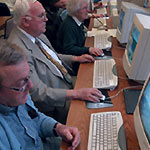In it for the long haul
With the help of major funders, Trinity reaches out to its
neighbors
by Jim H. Smith
Last summer, a group of Trinity and Hartford community leaders
traveled to Battle Creek, Michigan, to discuss with Kellogg
Foundation officials options for extending the five-year grant
through which Trinity has been reinventing its relationship with
the city since 1998. Reviewing the remarkable range of successes
Trinity has achieved with the funding, Kellogg asked the
delegation to generate a proposal for a transitional “bridge
grant” which, it is hoped, will set the stage for additional
Trinity funding.
“What we mean to do with additional Kellogg funding is
continue initiatives that have proven worthwhile since Trinity
received the initial grant and also figure out how to most
effectively institutionalize those things so their perpetuation
will not be dependent on external funds,” says Trinity
president Richard Hersh. “This project has had a very
successful beginning, but it will take time to deeply root the
programs and initiatives that have emerged from the Kellogg
grant.”
In late May, immediately after graduation, the entire faculty of
the College will go on a three-day retreat to continue a dialogue
begun last year about the future of curriculum and pedagogy. The
issues being discussed are directly related to how further
Kellogg funding will be invested.
It’s a timely meeting. If the proposal, submitted last fall,
meets with Kellogg approval, the bridge phase will start this
summer, says Professor James Trostle, associate professor of
anthropology and director of urban initiatives, who was
intimately involved in crafting the bridge grant. Evaluation and
consolidation, Trostle says, are key objectives of the bridge. To
understand what Trinity hopes to accomplish, it is useful to
reflect on what the College has accomplished with Kellogg funding
to date.
Can an elite liberal arts college
fundamentally recast its approach
to liberal education?
Trinity has always been a part
of Hartford. But the College’s
relationship with its home
city has sometimes been
ambivalent. And during the
closing decades of the
century, as the Frog Hollow
neighborhood immediately
surrounding the College fell
into decline, the relationship
with Hartford became
increasingly distant.
Leaders of the College realized it was time to step up to the
plate. Trinity could ill afford to ignore the urban squalor
around it. Research showed that many prospective students were
turned off by what they and their parents perceived to be a
dangerous neighborhood, where gang warfare over drug “turf”
resulted in many deaths in the early 1990s.
The question, though, was what Trinity should do. Should the
College merely try to “fix” Frog Hollow, a task so
monumental it was probably beyond the College’s means and
complicated by so many issues that it was almost certain to fail?
Or should it seek to embrace the community as a valuable
educational resource and play a leadership role in helping the
community rebuild itself?
| |
 |
| |
|
| |
 |
| |
|
| |
 |
| |
Classes at Hartford's Jubilee House use computers provided by
Trinity as part of a community outreach program. Also shown: A
Trinity dance class works with students at nearby Parkville
Community School. |
| |
|
A visionary solution
The solution, announced early in 1996, was visionary beyond most
people’s wildest dreams. In partnership with a group of
businesses and community organizations called the Southside
Institutions Neighborhood Alliance (SINA), the College would
pursue comprehensive community revitalization of the 15-block
surrounding area. It would invest in the community, but it would
also strive to empower the community to reclaim itself.
The centerpiece of that initiative was the Learning Corridor, a
16-acre complex of schools adjacent to Trinity’s campus. No
other public school campus in the nation combines the Learning
Corridor’s mix of educational institutions (a Montessori
Magnet School, a Magnet Middle School, and two Greater Hartford
academies that teach mathematics, science, and art) and support
programs for youths, including a Boys & Girls Club, the Aetna
Center for Families, and the Connecticut Valley Girl Scout
Council.
While the Learning Corridor was being developed, the College
simultaneously launched a strategic planning initiative aimed at
maintaining the vigor and responsiveness of Trinity’s
liberal arts education in a rapidly evolving world. The ambitious
plan called for integrating urban experience, increased
globalization, collaborative learning, and the extensive use of
information technology. The result, if it worked, would be a
broad slate of activities simultaneously enriching the
surrounding community and Trinity’s educational vision.
Whether it would work was the question that then-president Evan
Dobelle posed in 1998 when Trinity received the Kellogg funding.
“Can an elite liberal arts college fundamentally recast its
approach to liberal education? Can (Trinity) simultaneously help
the neighborhood, of which it has long been a part, transform
itself? And can it carry out these tasks not as two separate and
distinct projects but as one integrated, essentially seamless
process?”
Lesson one: The importance of evaluation
Five years later, the answer to the rhetorical questions Dobelle
posed would seem to be a qualified “yes.” Not only has
the Learning Corridor been completed, but it has also become a
source of pride for the neighborhood and for the city.
Additionally, Trinity has spearheaded a remarkable array of
programs to serve and interact with the community.
How effectively those programs have met the community’s
needs, however, is not entirely clear. “We’ve learned
some important lessons while producing these programs,” says
Trostle. “The first is about the value of ongoing evaluation
and assessment.”
Evaluation has not only been an ongoing process for Trinity, but
is also a matter of paramount interest to Kellogg. The foundation
made it clear, from the outset, that it wanted the College to
regularly monitor progress. Trinity’s innovative approach to
evaluation, which includes understanding community perceptions,
has produced strategies that Kellogg may seek to replicate
elsewhere.
At Trinity, it has produced a veritable mountain of data. One of
the key objectives of the bridge grant will be sorting through
that information and getting clarity about what it reveals. But,
says Trostle, that is only one of the values of research. “Evaluation
has also allowed us to bring groups of stakeholders together,
identify objectives, and determine how we have or haven’t
been making progress.” In doing that, the College has built
stronger and more enduring bridges to the community.
But evaluation has not been easy. “It was difficult on many
levels,” says Kent Smith, Trinity’s director of
institutional research and planning. “The College-community
connections related to the project reached well beyond the scope
of funding, so the evaluation had to enlist the cooperation and
assistance of organizations, both on and off campus, that were
not receiving any funding as part of the project. Our challenge
was to gain access and engender respect and cooperation.
Evaluation also had to reach beyond the traditional, formal
evaluation used for smaller and more focused projects.”
And then there were communications challenges within the
community that required creative solutions. Daniel Sibirsky, who
served as Kellogg evaluation coordinator under Smith for two
years, cites a good example of this process.
The College’s Trinfo.Café, just off campus, is a facility
designed to provide access to computer technology, including
classes, for people living in the area. After the Café had been
open for a few months, “We needed a snapshot of what changes
were occurring in the neighborhood,” says Sibirsky.
So, in the summer of 2000, Trinity conducted a survey, using a
door-to-door approach, similar to a census. Local residents were
hired and trained as interviewers. To maximize the chances of
obtaining data, they visited every housing unit in the area, up
to four times. When they found people at home, they interviewed
the one who’d celebrated his or her birthday most recently,
thus ensuring age diversity.
“When residents didn’t know about the Trinfo.Café and
our other programs, the interviewers gave them information and
discussed it with them,” says Sibirsky. “The process by
which we evaluated community awareness of and use of the Café
turned out to be as important as what we learned.”
Why? It revealed significant communications barriers, such as
language and illiteracy, that could not be bridged easily. In an
impoverished community, many of whose members are essentially
ambivalent about a college they perceive as an exclusive enclave,
it is not enough merely to provide tools and services like the
Trinfo.Café. Standard approaches to public relations may not
work.
“The research showed there is significant poverty in the
neighborhood still,” says Sibirsky. “The majority of
residents had limited knowledge of our programs. Hiring
residents, training them, and sending them door-to-door humanized
the programs and the College.”
As an immediate result of the interviews, Trinfo.Café reported
an increase in walk-in business. And the Aetna Center for
Families, an educational and family resource for neighborhood
residents supported by a $1-million grant from the Aetna
Foundation, also experienced a spike in inquiries about high
school equivalency programs that it offers. Equally important,
Trinity learned the importance of one-to-one communications in
Frog Hollow. Today, that approach has been institutionalized.
“Street captains,” local residents who serve as
communications liaisons in the neighborhood, have been identified
for every block in the neighborhood. They regularly convey
information from Trinity and gather information about community
reactions.
Lesson two: Community is a complex word
This system goes directly to the heart of the other major lesson
Trostle says Trinity has learned from the Kellogg project. “The
word ‘community’ is much more complex than we might
have imagined,” he says. “If there’s one thing we
now understand, it’s that there’s not just one
community surrounding the College. And there’s not just one
Trinity trying to change the community. This discovery has
compelled us to take a hard look at how the College transforms
itself in the process of trying to transform neighborhoods and
communities.
“There are no easy answers. Through the Kellogg grant we’ve
invested, for instance, in both physical facilities for the
community and in computers and connections. But it’s not
enough to simply provide these things. The challenge is helping
people in the community know how to use them. What do people in
the community want to use computers for? And what do they need to
know to achieve those goals?
“Similarly,” he adds, “we’re working toward
institutionalizing the College’s sustained ability to create
curricula, administrative structures, and programs where Trinity
students inevitably end up being involved in some capacity with
the city. We’re not there yet, but we’ve made progress.
It’s one of the long-term goals of additional funding.”
In the meantime, the demand for ongoing evaluation, says John
Langeland, Trinity’s director of information technology, has
“compelled the institution to rethink how we use
information, how it is taught, and, thus, how it is gathered.
From an information technology standpoint, we’re now being
called upon to formally track things that were never tracked in
the past. Not long ago, we couldn’t tell if community
learning was part of a class. Now all of the classes are
monitored carefully and we are constantly engaged in trying to
build systems that better support our goals.”
The most profound change that has happened at Trinity as a
consequence of the Kellogg funding, says Langeland, is that
“the institution has discovered that the neighborhood is a
truly valuable resource. More and more, faculty members and
administrators have discovered that we strengthen the
neighborhood and learning opportunities for our own students when
we interact.”
It’s a sentiment echoed by Jackie Mandyck, director of
community and institutional relations. “The Kellogg grant
has helped us develop multiple access points to the community,”
she says. “As a result, the College no longer views the
community as a liability. An institution such as ours needs to
step up and say, ‘This is our home. This is where we reside.
We care about our community and its health. We’re going to
do things academically and institutionally to help the community.
We’re in this for the long haul.’”
back to top |